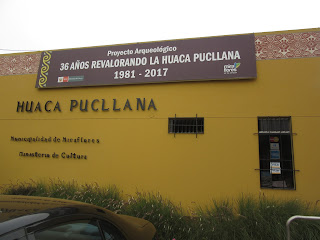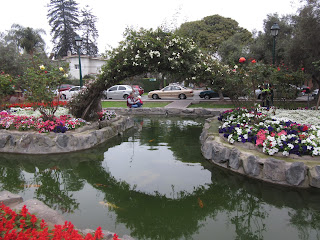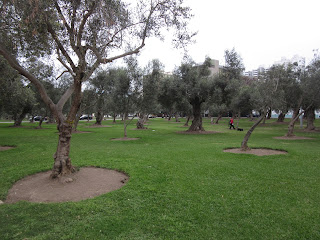Earlier in the day, we had spent time at a couple of museums before wandering through the Barranco and Miraflores neighborhoods of Lima. What appeared first to be a clay hill plunked down in the
middle of the latter was actually a huge adobe pyramid called Huaca Pucllana. It was attributed to the Lima culture who constructed a dozen major structures in and around what
is now Lima between 200 and 700 AD.
Only about twenty percent to thirty percent of the archaeological site has been restored so far. It was discovered when the mountain was used for motocross and bicycling! Recovery of Huaca Pucllana began in 1981 with the forced resettlement of those who occupied part of the architectural complex. Creation of the Huaca Pucllana Conservation Restoration Project Site Museum took place in 1984. We spent a short while wandering around the museum before our tour of the complex started.
We learned that the Pucllana Ceremonial Center was built between 450 and 650 AD during the height of what is now known as the Lima culture. Around 750 AD, after a period of abandonment that lasted for at least a century, the top of the great period was converted into a sacred space where deceased members of the Wari society's elite were interred.
Later, the people now known as from the Ychsma culture (1100 AD to 1450 AD) also used the site as a burial place for their dead and the repository of offerings associated with ancestor worship.
The Lima culture, which was developed on Peru's central coast, was governed by a caste of priests and the gods on whose half they interceded. Throughout its territory, the culture built a series of ceremonial centers where people would gather to celebrate feast days, discuss major events and receive instructions from their political and religious leaders.
The Lima culture, which was developed on Peru's central coast, was governed by a caste of priests and the gods on whose half they interceded. Throughout its territory, the culture built a series of ceremonial centers where people would gather to celebrate feast days, discuss major events and receive instructions from their political and religious leaders.
Pucllana was one of those centers. A great pyramid was built here composed of seven superimposed platforms and surrounded by other smaller structures. The main building material employed in the construction of the complex was mud bricks, the design of which changed over time.
Agriculture, livestock herding and fishing were the main subsistence activities engaged in during the Lima period. The construction of water channel systems for irrigation made it possible to extend areas of land for cultivation, thereby increasing agricultural production. Fishing activities were pursued close to shore and further out to sea with the shark being the most sought-after prey and the species seen as most central to the culture's world view and religious practices. The gathering of mollusks from beaches was also an important food source.
Textile and pottery objects, including some musical instruments, have been found at the complex by archaeologists. These provided clues to the everyday activities undertaken by the people of the Lima culture as well as the religious practices associated with the ceremonial center.
Textiles were important to the Lima society as both utilitarian and decorative objects. Knotting and plain-weave techniques were developed to produced a range of textile objects. The pieces so far discovered were mostly made of cotton.
Textiles were important to the Lima society as both utilitarian and decorative objects. Knotting and plain-weave techniques were developed to produced a range of textile objects. The pieces so far discovered were mostly made of cotton.
As part of their daily activities, the Lima culture produced pottery vessels of varying quality and in a variety of shapes which they decorated in black, red and white. The vessels were used for the storage, preparation and distribution of the foodstuffs and beverages consumed during great banquets. The feasts were accompanied by music played on clay panpipes, drums and flutes.
The structure of Wari culture was based on the imperial model with its capital in the present-day region of Ayacucho. During the 8th century, members of the society's elite were interred on the highest platforms of the Great Pyramid. Arranged in a sitting position, with their arms and legs bent, the bodies were wrapped in textiles and leaves. Then ropes were used to create a tight bundle, upon which a false head made of cloth or wood was fitted, along with clothing to give the impression of a seated individual. The carved, wooden head was intended as a new face for the after world.
Textiles for the afterlife during the Wari period were made
from cotton and camelid (i.e. alpaca, llama, etc) wool and included tunics, capes
and bags to accompany the dead into the next life.
Female figurines like these were intended as offerings.
Hair offering wrapped in vegetable fiber was one of the most
unusual items I've seen over the years!
When the tour began, the guide said the Huaca Pucllana
complex was rebuilt every ten to fifteen years on top of the old one as a new
government arrived but we had read nothing about that in the museum we’d just
toured. She mentioned that Huaca translated as 'sacred' and Pucllana
as 'place of games.'
A recently discovered pot showed a vessel with a
man carrying a shark on his back, proof that that this culture somehow
hunted 450 kg sharks. The vessel was an offering to the gods. I could have done without the figures from the Lima culture as they seemed very much out of place and very hokey for lack of a better word!
Some of the walls measured four meters in height. The guide told
the group the Lima people used red and white colors (and black, according to
the museum) in their ceramics.
The vessels discovered at Huaca Pucllana contained remnants
of fish and corn. Their principal meat was shark meat. The posts were
reproductions of ones that had been used to support the flat roofs of
buildings.
Original footprints of the Lima people who were estimated to
be about five feet tall. That wasn't a whole lot shorter than many of the Peruvians we came into contact with, especially those at higher altitudes.
Reconstruction of brick making during the Lima culture:
The guide pointed out the differences between the old and reconstructed bricks at the site.
Crops grown by the Lima culture included corn, yucca, beans and quinoa and
six varieties of fruit.
They developed plants close to the river and not where these crops were being grown, the site of the former temple.
What a stroke of luck Huaca Pucllana was discovered atop a hill in the middle of downtown Lima, just yards from bustling skyscrapers!
The guide explained that the pyramid complex was solid and
had no tunnels unlike those we visited in Egypt last year.
In the big square, 26 women were sacrificed as part of a
fertility rite. The ‘women’ ranged in age from only 12 to 25 and were already
mothers. They asked God for food and water in exchange to be killed.
The guide indicated that coca leaves and shells were found here which were offerings to the gods.
The guide explained that the yellow color was used because of the relationship with the
moon god. The color came from the lemonite mineral. Erosion caused the yellow
color to fade overtime. Some yellow was left in places only in the plaza.
About 650-750 AD, the Wari civilization came and conquered
the Lima people who left and returned 100 years later. Children were sacrificed to represent purity.
73 Wari tombs were found at the site. The poles were used to support roofs and also for protection from the sun.
A civil war occurred in 1000 AD. The Ychsma people, descendants
of the Lima people, used coca leaves when asking God for rain because Lima is in
a desert area. There are only 12mm of rain per year in Lima. Ironically, a
light drizzle was falling then!
A totem pole twas used to honor their dead ancestors.
The Lima people developed the complex like a pyramid, using ‘books’ in every space in
triangular form to release energy and to reduce the chance of earthquakes.
Unfortunately, I didn't get a lot out of our visit to Huaca Pucllana whether it was due to the late afternoon after having seen so many other sites that day, the uninspiring guide who didn't explain well what we were seeing or other factors. I found the information and the objects in the museum to be a great introduction to the architectural site and was prepared to be wowed by the ensuing tour. However, it left me feeling blah with more questions than answers.
Around 5, we got a taxi from Huaca Pucllana to Parque El Olivar located in the San Isidro neighborhood. There were
more original Beetles here than anywhere else, except probably Germany! Since
we were in Lima almost two months ago, we’ve also noticed the relatively large number
of Beetles throughout the rest of Peru, Bolivia and the other South American
countries we’ve since toured.
For years this rambling olive grove was slowly disappearing
as homes for wealthy citizens were built on its perimeter. The process was
halted in the 1960 in time to save more than 1,500 gnarled olive trees. The
trees were traced to saplings first brought to Lima by the Spaniards in 1560. Some
of the trees were more than a century old and still bore fruit.
A network of sidewalks, flower beds and fountains made the
park a popular spot for a late afternoon stroll.
The first doggie water fountain we’ve ever seen!
There seemed to be more olive trees here than on the Hill of
Olives in Jerusalem!
While walking through the park, a police officer on a Segway escorted us across a street for the first time!
The police presence in the area was very strong although
they were likely private guards. Each was so friendly and welcoming compared to
those we’d come across in the downtown core.
This area of Lima was clearly where the wealthy people
lived. The park was their backyards!
This police officer got off his Segway and asked us in English how we were doing, where we were from in the friendliest of manners. He had lived in Victoria, BC and had been all the way east to Nova Scotia, he said, as well as most of the states in the US! It was amazing how one person could change a perception of a city!
Chris: Here were some more indications for you that Halloween was a pretty major holiday in South America!
We were glad to get back to our guesthouse that night even though it was by far the crummiest one to date. It had been a long day, even by our standards, having started with touring the Mario Testino and Pedro de Osma Museums, before continuing with the quite forgettable Barranco neighborhood, then travelling downtown to the sights in the Miraflores section before ending up at the Huaca Pucllana pyramid and finally the beautiful olive grove.
Next post: Lima’s marvelous Museo MALI.
Posted on December 13th, 2017, from Rio de Janeiro, Brazil.































































Very interesting that I have never heard of the pyramid in Lima. Need to further research on it. You did too much on the day. Lil Red
ReplyDeleteUs do too much on that day - surely you jest!!
ReplyDelete